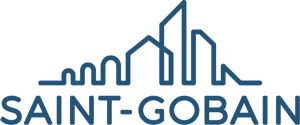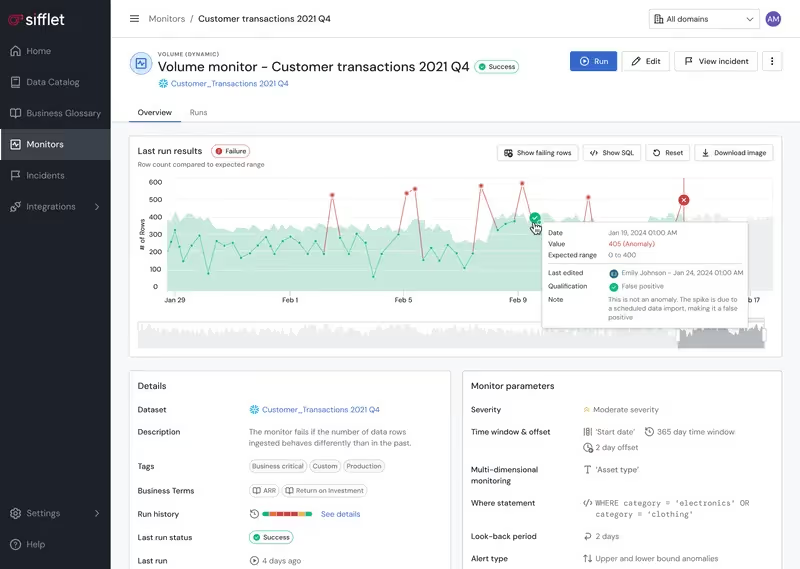Coverage without compromise.
Grow monitoring coverage intelligently as your stack scales and do more with less resources thanks to tooling that reduces maintenance burden, improves signal-to-noise, and helps you understand impact across interconnected systems.















Don’t Let Scale Stop You
As your stack and data assets scale, so do monitors. Keeping rules updated becomes a full-time job, and tribal knowledge about monitors gets scattered, so teams struggle to sunset obsolete monitors while adding new ones. No more with Sifflet.
- Optimize monitoring coverage and minimize noise levels with AI-powered suggestions and supervision that adapt dynamically
- Implement programmatic monitoring set up and maintenance with Data Quality as Code (DQaC)
- Automated monitor creation and updates based on data changes
- Centralized monitor management reduces maintenance overhead

Get Clear and Consistent
Maintaining consistent monitoring practices across tools, platforms, and internal teams that work across different parts of the stack isn’t easy. Sifflet makes it a breeze.
- Set up consistent alerting and response workflows
- Benefit from unified monitoring across your platforms and tools
- Use automated dependency mapping to show system relationships and benefit from end-to-end visibility across the entire data pipeline















Still have a question in mind ?
Contact Us
Frequently asked questions
How can executive sponsorship help scale data governance efforts?
Executive sponsorship is essential for scaling data governance beyond grassroots efforts. As organizations mature, top-down support ensures proper budget allocation for observability tools, data pipeline monitoring, and team resources. When leaders are personally invested, it helps shift the mindset from reactive fixes to proactive data quality and governance practices.
Is Sifflet suitable for large, distributed data environments?
Absolutely! Sifflet was built with scalability in mind. Whether you're working with batch data observability or streaming data monitoring, our platform supports distributed systems observability and is designed to grow with multi-team, multi-region organizations.
How does the rise of unstructured data impact data quality monitoring?
Unstructured data, like text, images, and audio, is growing rapidly due to AI adoption and IoT expansion. This makes data quality monitoring more complex but also more essential. Tools that can profile and validate unstructured data are key to maintaining high-quality datasets for both traditional and AI-driven applications.
Why did Shippeo decide to invest in a data observability solution like Sifflet?
As Shippeo scaled, they faced silent data leaks, inconsistent metrics, and data quality issues that impacted billing and reporting. By adopting Sifflet, they gained visibility into their data pipelines and could proactively detect and fix problems before they reached end users.
What’s the difference between technical and business data quality?
That's a great distinction to understand! Technical data quality focuses on things like accuracy, completeness, and consistency—basically, whether the data is structurally sound. Business data quality, on the other hand, asks if the data actually supports how your organization defines success. For example, a report might be technically correct but still misleading if it doesn’t reflect your current business model. A strong data governance framework helps align both dimensions.
Is Sifflet easy to integrate into our existing data workflows?
Yes, it’s designed to fit right in. Sifflet connects to your existing data stack via APIs and supports integrations with tools like Slack, Jira, and Microsoft Teams. It also enables 'Quality-as-Code' for teams using infrastructure-as-code, making it a seamless addition to your DataOps best practices.
How can data teams prioritize what to monitor in complex environments?
Not all data is created equal, so it's important to focus data quality monitoring efforts on the assets that drive business outcomes. That means identifying key dashboards, critical metrics, and high-impact models, then using tools like pipeline health dashboards and SLA monitoring to keep them reliable and fresh.
How do logs contribute to observability in data pipelines?
Logs capture interactions between data and external systems or users, offering valuable insights into data transformations and access patterns. They are essential for detecting anomalies, understanding data drift, and improving incident response in both batch and streaming data monitoring environments.




















-p-500.png)
